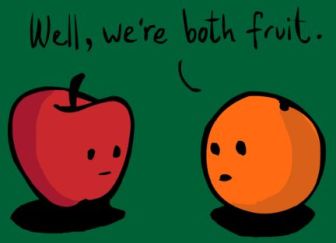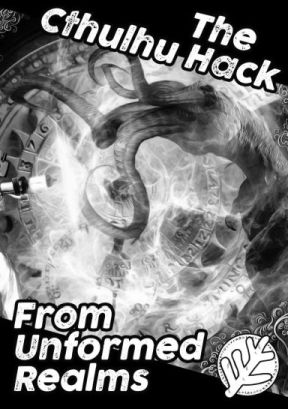Apples, Oranges, Arguments
From October 2013 (with some edits):
“You can’t compare apples to oranges.”
They, whoever “they” are, say this a lot, often, in my experience, without giving much thought to what the saying means. Instead, this common idiom seems to be used most of time as an expression of contempt, of dismissing what a person just said as if it were not worthy of a serious response.
Properly used, the apples-to-oranges idiom reminds us to be on guard against false analogies. It reminds us that two things that appear superficially similar in some regard may still be importantly different in other ways. For example, I can compare the solar system to an atom. I could say, “Just as planets orbit the sun, so to do electrons orbit the nucleus of an atom.” While this comparison may help a student visualize the structure of an atom, as science per se the comparison is less than helpful. Electrons can jump from orbit to orbit, or even leave orbit entirely. From this observation, I cannot reasonably conclude that planets do the same thing. Or, taken the other way, from the observation that planetary orbits tend toward stability and regularity, I cannot conclude that electrons behave the same way planets do. To do either of these things would be to make a false analogy.
Consider another example. I have former students who are now married and have children of their own. I can remember that this former student, when he or she was in my class, exhibited certain characteristics, such as laziness or honesty. I cannot reasonably conclude from that memory that the student’s children will exhibit the same characteristics. Just as I cannot compare apples to oranges, meaning I cannot convict an orange for not being an apple, I cannot assume that a child will exhibit the same characteristics that the child’s parent did in my class more than 10 years ago.

Now, all of that said, it is important to realize that “You can’t compare apples to oranges” is only contingently true. It is only true if certain preconditions apply. Otherwise, the idiom cannot be fairly used. After all, anyone can sensibly note that, yes, apples and oranges can be compared because they’re both fruits. They are both part of a larger set that includes strawberries, bananas, papayas, and mangos as well. Therefore, any comparison between apples and oranges that relies on characteristics common to the larger set of fruits, such as the presence of fructose or seeds, would not be a false analogy.
To speak zoologically, I can fairly compare any member of the family Felidae so long as I limit my comparisons to traits common to that family. I cannot claim that they are all the same in that they can purr, for example. Animals in the genus Panthera belong to the family Felidae, but they cannot purr. That is a characteristic of genus Felis, another member of the Felidae family. To say that Felis, part of Felidae, can purr means Panthera, also part of Felidae, can also purr is to compare apples to oranges. To say that members of the genus have fur or claws or are carnivores is not comparing apples to oranges.
So, what’s my point?
Well, my point is that trotting out a clichéd idiom is no substitute for an honest argument. An honest argument requires that, at a minimum, I seriously consider the truth of whatever my interlocutor states. This requires humility on my part. Even if I am not wrong about whatever issue is under consideration, I need treat the other side as if I could be wrong. Otherwise, I run the risk of being dismissive. This might get the other person to stop talking, but it isn’t going to demonstrate that I am correct.
Of course, humility and an honest effort to view someone whom I disagree with as worthy of respect can require effort, and I think that is probably why the apples-to-oranges idiom is, in my experience, used as a way of shutting down conversation. It’s a mildly clever way of saying, “You don’t know what you’re talking about so you should stop talking.” Dismissive rhetorical devices aren’t anything new. Socrates, for example, in the 400s B.C. waged philosophical battles against people who were merely clever rather than genuinely thoughtful.
In classical education, we don’t want our students to be merely clever. We want them to struggle toward the transcendentals: the True, the Good, and the Beautiful. Contrary to popular opinion, whether something is true, good, or beautiful isn’t just a matter of opinion. Some things really are objectively true. To think otherwise isn’t to express an equally valid opinion, but instead is to be in error. This is most obvious in mathematics. Two and two are four. The reciprocal of one-half is two. These statements, and many others, are true regardless of what I think or want. Likewise, some things are good. Period. Some things are beautiful. Period. As I’ve told my students more than once, someone who says a rose isn’t beautiful is incorrect. Someone who claims that all moral statements are matters of opinion or societal convention is likewise incorrect.
What muddies the waters, especially when discussing the Good and the Beautiful, is that it is often difficult to arrive at a firm conclusion. Even after careful consideration, doubt may remain. “It is wrong to X,” where X stands for some activity, is a common claim. Demonstrating the truth of that claim is not as common. It is easy to assert. It is harder to present a reasoned demonstration that takes seriously the objections of those who disagree. And, because it is harder, many people just don’t bother. Instead, people substitute volume for reason.
“It is wrong to X!” is countered by “No, it isn’t!” Few people seem to advance their arguments much beyond just trying to shout the other side down. This is dangerous. If we abandon the conviction that the True, the Good, and the Beautiful are objective categories that can be discovered, however imperfectly, by human reason, then we reduce all arguments about truth, morality, and art to shouting matches. The winner is whoever shouts the loudest, whoever can apply the most force to get the other side to surrender. Throughout human history, societies have abandoned human reason in favor of force. The results — from the Reign of Terror to the killing fields of Cambodia and beyond — have never been pleasant.
As a teacher in a classical education school, encouraging the reasoned search for the transcendentals is my hardest task. I find myself working against so much of what passes itself off as popular culture, which isn’t really culture at all, but instead is just mass marketing aimed at conformity. I not only have to try to get my students to discover the power of their own reason, but I also have to try to get them to respect that same power in others, especially when they disagree.




